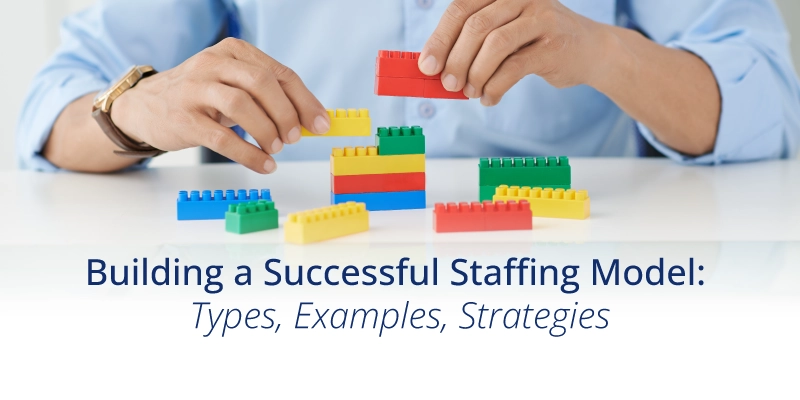Building a Successful Staffing Model: Types, Examples, Strategies
Building a Successful Staffing Model: Types, Examples, Strategies (Infographic)
In today’s competitive business environment, having a robust and flexible staffing model is essential for success. As companies navigate fluctuating market demands, technological advancements, and an evolving workforce, the ability to adapt quickly and efficiently becomes a significant advantage. Businesses with dynamic staffing models are better positioned to respond to changes, leading to higher productivity and improved employee satisfaction.
The importance of staffing models continues to grow as organizations strive to balance cost, efficiency, and employee engagement. A well-structured staffing model provides a clear framework for hiring, training, and retaining employees, ensuring that the right people are in the right roles at the right times. This strategic approach helps companies optimize their resources, reduce turnover, and maintain a competitive edge.
Learn everything you need to know about staffing models here, from what a staffing model is and the various types of staffing models to strategy. This article aims to help your business identify and adopt the staffing models that best suit your unique needs and goals. Start by learning the definition of a staffing model in the infographic below.

What Is a Staffing Model?
A staffing model refers to a structured framework that outlines how an organization plans to meet its workforce needs. It involves assessing current and future staffing requirements, identifying the types of employment necessary (such as full-time, part-time, temporary, or contract), and developing strategies to attract and retain talent. Effective staffing models consider factors such as workload fluctuations, skill gaps, and long-term business objectives.
6 Types of Staffing Models
1. Fixed staffing
This staffing type involves hiring employees on a full-time or part-time basis with no predetermined end date. This model provides stability, fosters employee loyalty, and helps build a skilled and experienced workforce. However, it also comes with higher long-term costs and less flexibility in adjusting to workload changes.

2. Variable staffing
In the variable staffing model, workforce size depends on demand. You hire more employees to address seasonal fluctuations or market upturns. This model offers flexibility, allows for quick adjustments to workforce size, and can reduce labor costs during low-demand periods. However, it may lead to higher turnover rates and potential challenges in maintaining consistent quality.
3. Staff augmentation
Staff augmentation or contingent staffing entails expanding your full-time workforce with temporary hires to complete specific projects or achieve a short-term business goal. This approach provides access to specialized skills, cost control, and flexibility in managing project timelines. On the flip side, it often results in limited employee loyalty and potential legal complexities in contract management.
4. Outsourcing
Outsourcing delegates certain business functions or projects to external organizations or service providers. This staffing model can lead to significant cost savings and access to specialized expertise, as well as allow the internal team to focus on core activities. However, it also means less control over quality and potential risks related to confidentiality and data security.
5. Freelance and gig economy
This type of staffing leverages independent contractors or freelancers for specific tasks or projects. This model offers high flexibility, access to a diverse talent pool, and cost-efficiency. Nonetheless, it comes with challenges, such as variable quality of work and potential issues with worker reliability and continuity.
6. Hybrid staffing model
The hybrid staffing model combines various staffing approaches to create a flexible and responsive workforce strategy. This model balances stability and flexibility, optimizes resource allocation, and adapts to changing business needs. However, it requires careful management and coordination to ensure consistency and efficiency.
5 Examples of Staffing Models Across Industries
Knowledge about different staffing models can provide valuable insights for businesses looking to optimize their workforce management. Here are several examples of staffing models and how they can be effectively implemented across various industries.
1. Fixed staffing in a corporate setting
Fixed staffing is essential for ensuring stability and consistency in a corporate environment. This model involves hiring full-time employees who are committed to the company’s long-term goals. It allows businesses to develop a skilled and experienced workforce, fostering employee loyalty and higher productivity.
Continuous training and development programs can further enhance employee skills, improving retention rates and contributing to the company’s growth.
2. Staff augmentation in a manufacturing environment
Manufacturing firms often face fluctuating demand for their products, which makes contingent staffing an ideal solution. By partnering with staffing agencies, these firms can bring in temporary workers during peak periods to meet production needs.
This model provides flexibility, allowing companies to scale their workforce up or down based on demand. Staff augmentation also helps control labor costs and will enable employers to evaluate workers’ performance before potentially offering them permanent positions.
3. Hybrid staffing model in a tech startup
Tech startups benefit from a hybrid staffing model that combines permanent employees with freelancers and contract workers. Permanent staff focus on core functions such as product development and customer support, while freelancers and contractors are hired for specific projects and expertise.
This staffing model example provides the agility needed to respond to market changes and access specialized skills without long-term commitments. It also allows startups to manage their budgets more effectively, investing in key areas while maintaining the ability to scale operations as needed.

4. Variable staffing in a retail company
Retail companies often experience significant increases in customer traffic during holiday seasons, making seasonal staffing a practical solution. By increasing staff size during peak shopping periods, these companies can maintain high levels of customer service without the long-term financial commitment of permanent employees.
Variable staffing ensures that businesses can handle increased workloads efficiently while keeping labor costs manageable during off-peak periods. This model also offers opportunities to identify potential long-term employees from the seasonal workforce.
5. Project-based staffing in a construction firm
Construction firms with fluctuating project demands often use project-based staffing to meet their workforce needs. Hiring employees specifically for the duration of each project ensures that firms have the right expertise at each stage of construction.
Project-based staffing allows firms to be highly responsive to project requirements and client needs, providing flexibility in workforce management. This approach enables construction companies to bring in specialized skills as needed without the overhead costs of a large permanent workforce.
10 Strategies for Implementing Staffing Models
Successfully implementing a staffing model requires careful planning, assessment, and ongoing management. Here are some strategic approaches to ensure that your chosen staffing model aligns with your business needs and goals.

1. Assess organizational needs
The first step is to thoroughly evaluate your organization’s current workforce structure, identifying skill gaps and projecting future staffing requirements based on business growth and market trends. Conducting a comprehensive workforce analysis helps determine the most suitable staffing model for your company.
2. Identify the right staffing model
Evaluate different types of staffing models to determine which best suits your organizational needs. Consider factors like the nature of your industry, workload fluctuations, and the specific skills required.
3. Align with business goals
Ensure that your staffing strategy supports your company’s strategic objectives. For example, if your goal is rapid expansion, a hybrid staffing model that includes a mix of permanent and temporary staff might be beneficial.
4. Ensure flexibility and scalability
Your staffing strategy should allow for adjustments based on changing business needs. Incorporate flexibility to scale your workforce up or down as required by market demands. Achieve this ability by integrating temporary staffing or outsourcing specific functions to manage peak periods efficiently.
5. Develop clear policies and procedures
Establish clear guidelines and policies for hiring, onboarding, and managing different types of staff. This procedure includes defining roles and responsibilities, performance expectations, and evaluation criteria. Clear policies ensure consistency and fairness in workforce management.
6. Invest in technology and tools
Utilize staffing and HR management software to streamline the hiring process, track employee performance, and manage workforce data effectively. Technology can also facilitate communication and collaboration among different types of workers, enhancing overall productivity.
7. Provide training and development
Invest in continuous training and development programs for all employees, whether permanent or temporary. Skills training not only enhances skills but also improves retention rates and job satisfaction. A well-trained workforce is more adaptable and capable of meeting the company’s needs.
8. Monitor and adjust the staffing model
Implementing a staffing model is not a one-time effort but requires continuous monitoring and adjustment. Regularly review your staffing strategy and make necessary adjustments to ensure alignment with business objectives. Collect data on key performance indicators (KPIs) such as employee productivity, retention rates, and cost-effectiveness to identify areas for improvement.
9. Adapt to changes in the business environment
Stay informed about industry trends, market conditions, and changes in labor laws that might impact your staffing model. Being proactive and adaptable allows you to respond quickly to external changes and maintain a competitive edge.
10. Seek feedback from employees
Regularly seek feedback from your workforce to understand their needs and concerns. Their insights can help you make informed decisions about staffing models and improve employee satisfaction and engagement.
Building a Future-Ready Workforce
Implementing an effective staffing model is not just about filling positions; it’s about strategically aligning your workforce with your business goals to drive success.
Whether you opt for a traditional model, a hybrid approach, or something more tailored to your industry, the key is to understand your specific needs and continually assess and adjust your strategy. As workforce trends continue to evolve, being flexible and open to innovative staffing solutions can keep your company competitive and agile.

If you’re ready to optimize your staffing strategies and enhance your workforce management, consider partnering with Recruiting Connection. We’re a specialized recruiting agency in Salt Lake City that can provide tailored solutions that align with your company’s unique needs and goals.
Reach out to the team and discover how we can help you find the best talent.

Struggling to find top
talent for your business?
Connect with the expertes at Recruiting Connection and discover the difference our full-service recruitment can make.
Contact Us Today
















